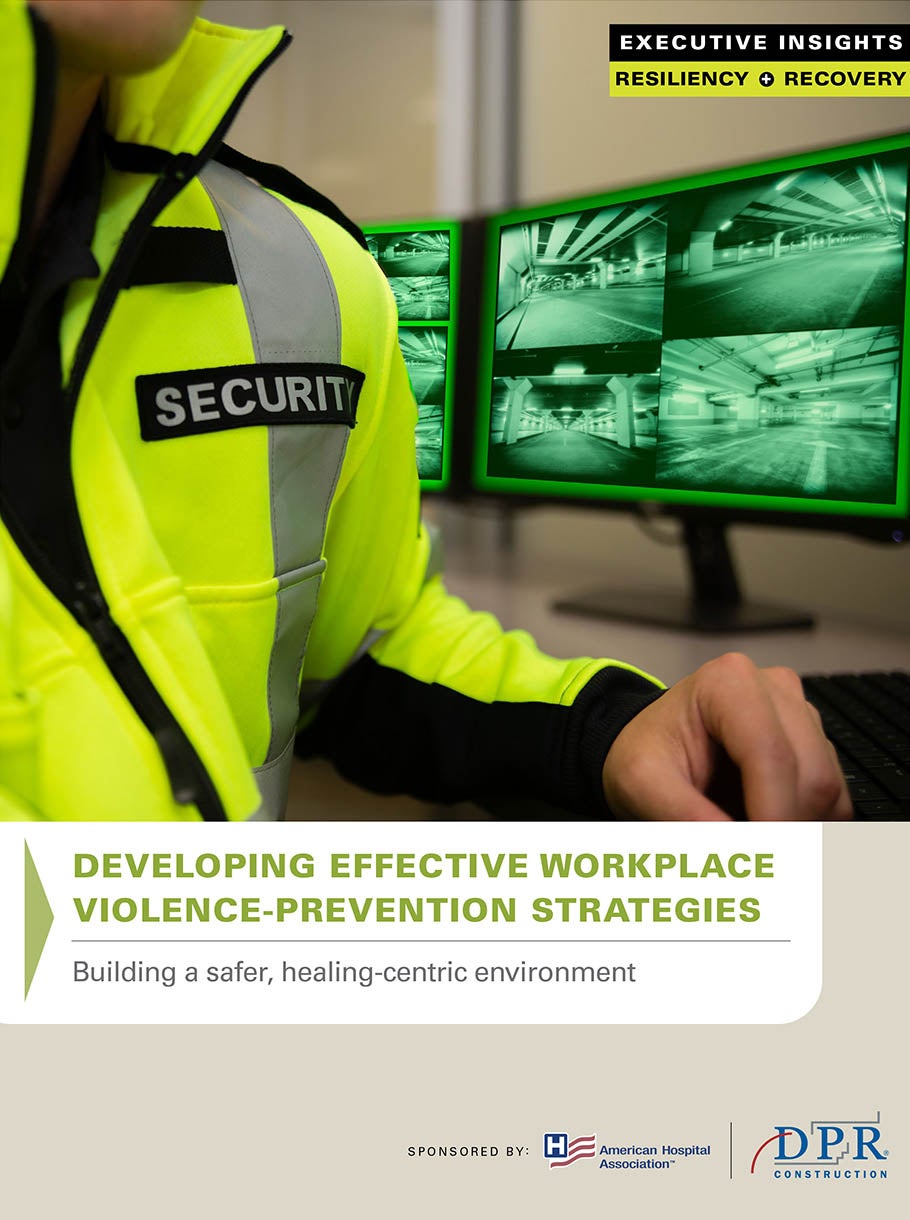
Developing Effective Workplace Violence-Prevention Strategies

Developing Effective Workplace Violence-Prevention Strategies
AHA Knowledge Exchange
Building a safer, healing-centered environment
Threats against health care workers are on the rise. The federal government reports that health care workers are five times more likely to experience workplace violence than employees in all other industries. Hospitals are working to protect their staff and patients by identifying security risks with artificial intelligence (AI)-enabled monitoring and reporting systems, modifying facilities and expanding use of security technologies, adding barrier protection and exit routes, calling in de-escalation teams, and training staff in violence prevention. This executive dialogue explores how hospitals are using technology and training to mitigate risk, redesigning facilities and workflow processes to prioritize safety and re-envisioning relationships with hospital security and others to support prevention and crisis response.
Key elements of comprehensive workplace violence prevention and intervention
- Develop a comprehensive workplace violence-prevention program that educates team members to recognize potential situations, de-escalate and manage those behaviors, when to involve security and various reporting methods.
- Equip staff with annual, nonviolent crisis-intervention training based on job code. Staff in the emergency department (ED), behavioral health, security, and house supervision, should receive the highest level of training.
- From a design aspect, new facilities and any renovations should go through a Crime Prevention Through Environmental Design study. Create a scoring scale to determine what level of security is needed.
- In areas with significant violence-risk factors like EDs, evaluate and employ weapons detection systems and equip staff badges with a real-time locating system to summon help and the precise location of the emergency.
- Depending on the location and violence threat, train security staff with tasers, firearms or gel pepper spray.
- Assess the vulnerability of off-site locations. Distribute wearable panic buttons to staff in off-site locations with the alarm going directly to 911 and consider boosting security rounding.
- Look at autonomous security robots for larger health care locations that don’t have security personnel. These automated guards perform security tasks, combining self-driving technologies, robotics and AI.
- Address the community behavioral health needs with other partners through outpatient, virtual or other methods of intervention, rather than admitting patients into an inpatient unit with limited capacity.
- Use dogs to provide strength, comfort and emotional support to individuals, families, communities and first responders who experience intense traumatic emotions in the aftermath of critical incidents.
Participants

Tom Carrico
Vice President and Chief Operating Officer
Baptist Health Hardin

Benjamin Carter, CPA, FHFMA
Executive Vice President and Chief Operating Officer
Trinity Health

Katie Chieda, R.N., BSN, MSN/MBA, CENP
Chief Nursing Officer
Fisher-Titus Health

Cynthia Dry, R.N., MSN
Chief Clinical Officer
ScionHealth, Hospital Division

Jay Farhat
Executive Director, Protective Services
Baptist Health

Rachel Faulkner, R.N., MBA, CPHQ, LSSGB
Chief Quality Officer
Cameron Memorial Community Hospital

Oscar Garcia, MS
Security Director
Methodist Hospital

Larisa Goganzer, R.N., MSN, FACHE
Senior Vice President and Chief Hospital Executive
AtlantiCare

Matthew Griffin, M.D., MBA, FACEP
Chief Medical Officer/Hospital Administrator
Trinity Health Livonia Hospital

Kelly Johnson, PhD, R.N., NEA-BC
Senior Vice President and Chief Nursing Officer
Children’s Hospital Los Angeles

Crystal Losing, R.N.
Chief Nursing Officer
Logan Health–Cut Bank

Chuck Pickering, MBA, MPH
Vice President of Facilities and Support Services
Children’s Hospital Los Angeles

Deb Sheehan, ACHE, DBIA
Healthcare Market Strategy Leader
DPR Construction

Eric Zell
Construction Project Manager
Cincinnati Children’s Hospital

Moderator:
Suzanna Hoppszallern
Senior Editor
American Hospital Association
AHA Knowledge Exchange
Gain insights from the C-suite and health care leaders on the most pressing issues and transformational strategies.








